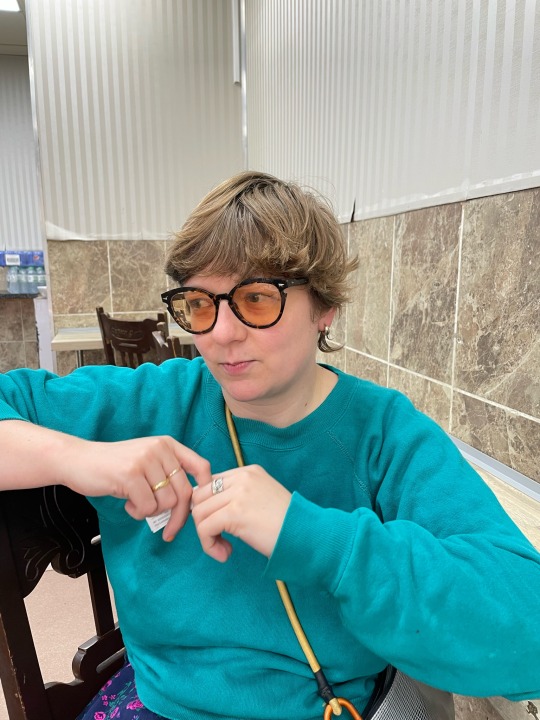Text
"Crip time is time travel. Disability and illness have the power to extract us from linear, progressive time with its normative life stages and cast us into a wormhole of backward and forward acceleration, jerky stops and starts, tedious intervals and abrupt endings. Some of us contend with the impairments of old age while still young; some of us are treated like children no matter how old we get."
- Ellen Samuels, Six Ways of Looking at Crip Time (2017)
1 note
·
View note
Text
youtube
Jesse Darling's Site Visit – A Road Trip Movie | Turner Prize Winner | Tate
September 29, 2023
Where are we, Jesse? The answer is not clear. In this video, artist Jesse Darling and a small film crew go on a road trip across the UK. Passing through seaside towns, container ports, service stations, retail parts and an abandoned airport, this is a journey that encounters at every turn the barriers and borders (both physical and invisible) of modern Britain. It’s a journey without a final destination, but one that hints at just how complicated and connected, how wonderful and terrible everything is.
0 notes
Text
PSA from the actual coiner of “neurodivergent”
Yo. Many of you need to take an entire stadium of seats. Like a football arena in Texas number.
I coined neurodivergent before tumblr was even a thing, like a decade or more ago, because people were using ‘neurodiverse’ and ‘neurodiversity’ to just mean autistic, & possibly LDs. But there’s more, like way more, ways a person can have a different yet fucking perfect dammit brain.
Neurodivergent refers to neurologically divergent from typical. That’s ALL.
I am multiply neurodivergent: I’m Autistic, epileptic, have PTSD, have cluster headaches, have a chiari malformation.
Neurodivergent just means a brain that diverges.
Autistic people. ADHD people. People with learning disabilities. Epileptic people. People with mental illnesses. People with MS or Parkinsons or apraxia or cerebral palsy or dyspraxia or no specific diagnosis but wonky lateralization or something.
That is all it means. It is not another damn tool of exclusion. It is specifically a tool of inclusion. If you don’t want to be associated with Those People, then YOU are the one who needs another word. Neurodivergent is for all of us.
Annoyedly yours,
Neurodivergent K of Radical Neurodivergence Speaking
43K notes
·
View notes
Text
I’ve observed how fragility is rampant, especially in the so-called “west”. Individualism has weakened people immeasurably. Isolation has cut people off from the very things we need to thrive— community & connection to our ecosystems. Alienation has made people un-resilient. People end up being stuck doing something for far too long— over processing feelings, over intellectualizing oppression in their heads, mobilizing rapidly/ intensely/ constantly only to burnout shortly after, avoiding emotional vulnerability in community while fixating on productivity even within activism, etc. It doesn’t help the individual and it surely doesn’t help the collective.
Amazing piece by Ayesha Khan!
508 notes
·
View notes
Text
"As my previous work on the case study makes explicit, I am extremely interested in generalization: how the singular becomes delaminated from its location in someone’s story or some locale’s irreducibly local history and circulated as evidence of something shared. This is part of my method, to track the becoming general of singular things, and to give those things materiality by tracking their resonances across many scenes, including the ones made by nonverbal but still linguistic activities, like gestures. Aesthetics is not only the place where we rehabituate our sensorium by taking in new material and becoming more refined in relation to it. But it provides metrics for understanding how we pace and space our encounters with things, how we manage the too closeness of the world and also the desire to have an impact on it that has some relation to its impact on us."
from the Introduction to Cruel Optimism by Lauren Berlant, 2011
0 notes
Text
A Handsome Testimonial
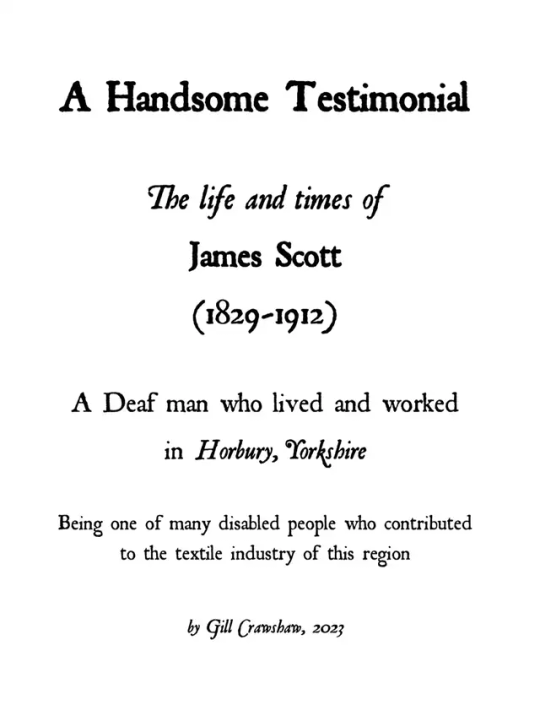
A handsome testimonial by Gill Crawshaw - This zine takes the life of James Scott as its starting point, to show how disabled people contributed to the textile industry of Yorkshire, and to their communities.
James was one of the pupils of the Yorkshire Institution for the Deaf and Dumb (YIDD), who lived in Horbury, near Wakefield, for the rest of his life once he left the school. He worked for Richard Poppleton at Albert Mill, Horbury Bridge, as a hanker of worsted fabric. His employer provided a glowing report of James for the survey that YIDD carried out about their former pupils. I was able to trace James's life through all the censuses. This shows that he carried on living with - and supporting - his mother till she died. Importantly for this project,he continued to work in a worsted mill (perhaps the same one throughout his working life), listed sometimes a a worsted packer or warehouseman. When he got older he became a lamplighter.
James's story gave Gill an opportunity to think about how disabled people were viewed at that time, and how this influences views of disabled people today.
With support of the Empath History Research Group in Wakefield, I found out about James's family members too, although they didn't all make it into the zine. James's sister Agnes does feature though. Her experience was a sharp contrast to James's.
Primarily, I aimed to show how disabled people are part of society, part of the local economy, and part of life! Stereotypes might suggest that disabled people are dependent on others, but this is definitely not the whole story.
Read the zine here: https://issuu.com/gillcrawshaw/docs/a_handsome_testimonial_lo_res_zine
1 note
·
View note
Text

Open 8 September 2023 - January 2024, at Leeds Industrial Museum.
Any work that wanted doing is an exhibition that brings disabled people’s voices from the past and present together, highlighting their contributions to heritage and contemporary culture. Artworks created in response to the hidden histories of disabled mill workers will be displayed amongst Leeds Industrial Museum’s collection of textile machinery.
From the eighteenth century onwards, the industrialisation of the textile industry led to large numbers of workers becoming disabled due to dangerous factory conditions. Many of these people did not leave the workforce, and instead joined other disabled people who were already doing useful, skilful work in the textile mills. Yet the lives of disabled people have largely been omitted from history unless they are portrayed as tragic victims dependent on the goodwill of others, or as scroungers and benefit cheats. This isn’t the whole story.
Disabled people have played their part in the textile industry and in their communities, from ordinary working people, to those who added their voices to campaigns for factory reform. This exhibition’s title is taken from the 1833 testimony of one of those workers who spoke up against harsh working conditions.
The artists in this exhibition are taking this legacy forward. By making art for Armley Mills, once the largest woollen mill in the world, they are reclaiming the space for conversations about disability and disabled people’s lives. They make connections between the past and the situation of disabled people today informed by their own experiences and those of other disabled people.
Any work that wanted doing is curated by Gill Crawshaw, working in partnership with Leeds Museums and Galleries, and supported by Leeds 2023, funded by the National Lottery Heritage Fund.
0 notes
Text
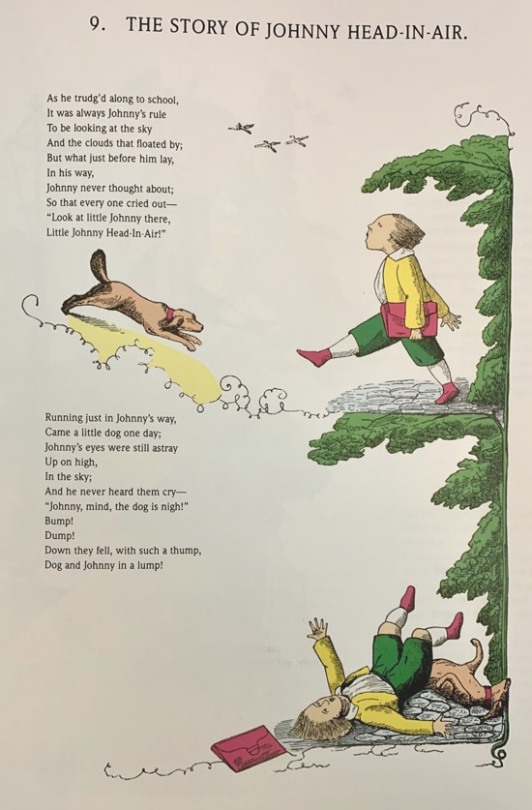
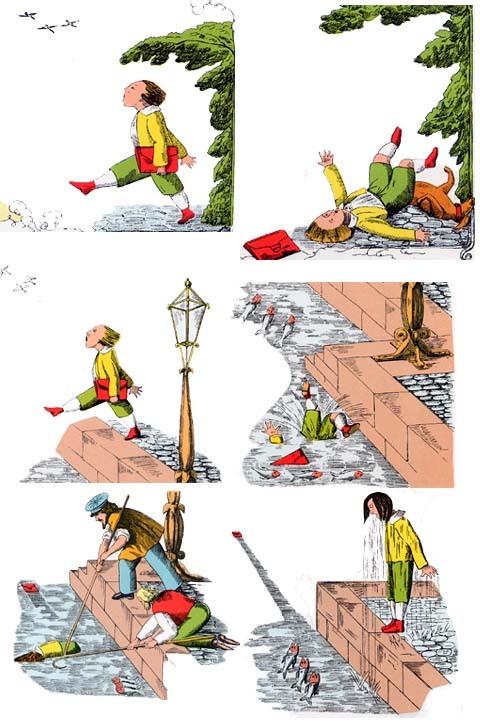
"Another story in Hoffmann’s “Struwwelpeter” relevant to the present review is that of “Johnny Look-in-the-air”, which was added in the 5th edition in 1847 (Seidler 2004). In this story, Hoffmann depicts a boy showing significant symptoms of inattention. Johnny was always “looking at the sky and the clouds that floated by” (Hoffmann 1846, English edition) and was therefore “often easily distracted by extraneous stimuli” (American Psychiatric Association 2000). Johnny’s inattentiveness resulted in the collision with an approaching dog and climaxed in an accident as “Johnny watch’d the swallows” (Hoffmann 1846, English edition). He finally fell into a river.
Some authors are convinced that the stories of Johnny Look-in-the-air and Fidgety Phil are early descriptions of ADHD (Burd and Kerbeshian 1988; Köpf 2006; Thome and Jacobs 2004). However, Johnny Look-in-the-air’s retropulsion of the head may also be interpreted as a description of a petit mal absence (Nissen 2005). Petit mal absences show a wide variety of mild to moderate motor accompaniment, and retropulsion of the head is quite common (retropulsive petit mal, Janz 1969). There are also critics who advance the view that Hoffmann’s Fidgety Phil is simply an example of a naughty child (Seidler 2004). Seidler (2004) refers to the fact that the final version of the scene’s pictures published in 1859, which is the artwork still used in modern editions, differs from the original version of 1845. Seidler (2004) sees in the slightly different gestures of the protagonists a completely different situation, namely an open conflict between a father and his naughty, misbehaving son. The father’s initial admonition provokes the son’s deliberate defiant behavior indicated by eye contact and the active gripping of the tablecloth by the son (Seidler 2004). Hoffmann’s storybook was published at a time when educational warning stories were very popular (Herzog et al. 1995). Each of Hoffmann’s stories demonstrates a child’s misconduct leading to fatal consequences including death of the child. It is therefore possible that he wanted children to learn from his stories."
From A history of attention deficit hyperactivity disorder (2010)
1 note
·
View note
Text
Zappelphilipp (Fidgety Phil) by Heinrich Hoffman, 1844
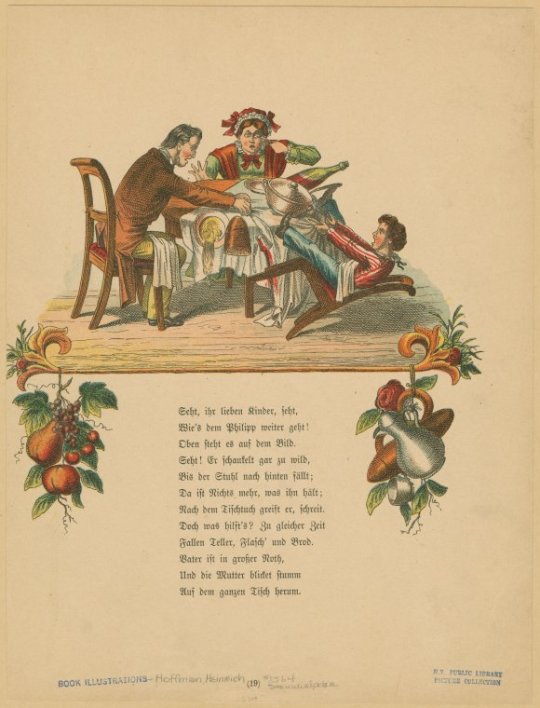
An illustration created in 1844, thought to be ab early depiction of ADHD in literature.
Image courtesy of New York Public Library Digital Collections
"In 1844, the German physician Heinrich Hoffmann created some illustrated children’s stories including “Fidgety Phil” (“Zappelphilipp”), who is nowadays a popular allegory for children with ADHD. Hoffmann was born in Frankfurt/Main in 1809. He studied medicine in Heidelberg, Halle, and Paris (Herzog et al. 1995). In 1835, he became a general practitioner and obstetrician in Frankfurt/Main (Herzog et al. 1995). In 1851, he was employed at the mental hospital of Frankfurt (“Anstalt für Irre und Epileptische”) and became a successful psychiatrist (Herzog et al. 1995). Hoffmann rejected the common opinion of his time that psychiatric patients were obsessed or criminal, but rather regarded mental disorders as medical issues (Thome and Jacobs 2004). In 1861, he founded a new and very advanced hospital in Frankfurt. He was head of this institution until his retirement in 1888 (Herzog et al. 1995; Thome and Jacobs 2004) and was known for his revolutionary efforts to improve the conditions of psychiatric patients (Thome and Jacobs 2004)."
"In the story of Fidgety Phil, Hoffmann illustrates a family conflict at dinner caused by the fidgety behavior of the son and culminating in his falling over together with the food on the table. This can be interpreted as an early case of ADHD. At the beginning of the story, the father asks “in earnest tone” (Hoffmann 1846, English edition): “Let me see if Philip can be a little gentleman; Let me see if he is able to sit still for once at table” (Hoffmann 1846, English edition). The initial statement suggests that the father had anticipated some misbehavior of his son at table, indicating that this was no singular or occasional event. It is a first hint at the presence of an underlying persistent disorder. The DSM-IV-TR currently postulates that, for a diagnosis of ADHD, the symptoms “have persisted for at least 6 months” (American Psychiatric Association 2000). Subsequently, Hoffmann describes symptoms of inattention and hyperactivity in Philipp. The boy’s reaction to his father’s admonition reads in the original German text as follows: “Doch der Philipp hörte nicht, was zu ihm der Vater spricht” (Hoffmann 1948), which, literally translated, means “but Philipp did not listen to what the father was saying to him”. This behavior represents explicit symptoms of inattention. The DSM-IV-TR describes that the patient “often does not seem to listen when spoken to directly” and “often does not follow through on instructions (…) [what is] not due to oppositional behavior” (American Psychiatric Association 2000). Instead of following his father’s request, Philipp “wriggled and giggled, and then, I declare, swung backward and forward and tilted his chair” (Hoffmann 1846, English edition). This description can be interpreted as symptoms of “motoric overactivity” (Burd and Kerbeshian 1988) and is close to the first symptom of hyperactivity characterized in the DSM-IV-TR: “often fidgets with hands or feet or squirms in seat” (American Psychiatric Association 2000). Hoffmann depicts Philipp’s motor activity as being excessive enough that “his chair falls over quite. Philip screams with all his might, catches at the cloth, but then that makes matters worse again. Down upon the ground they fall, glasses, bread, knives forks and all” (Hoffmann 1846, English edition). The fact that Philipp’s parents become very angry in the story (Hoffmann 1948) may hint at another DSM-IV-TR criterion, i.e. the behavior of children suffering from ADHD often causes conflicts and a “significant impairment in social (…) functioning” (American Psychiatric Association 2000)."
Both from The history of attention deficit hyperactivity disorder (2010)
0 notes
Text
youtube
"Once I became a woman in her thirties, and had a husband and more of a place for myself in the world, I became more interested in the ways that people kind of sabotage coming together. And thinking that we aren't very good at that, and that's okay! The ways that we don't come together are very unique, and they are their own language."
1 note
·
View note
Text
TC Since 2016 you’ve been part of an art writing collective called Yellow Pen Club while also building a career as a critic. It seems you’ve found a way to bridge the collective and individual narratives of your youth.
JY I didn’t realise it at the start, but YPC is rather peculiar. We aren’t just copy-editing and commenting on completed writing; we participate throughout the entire process, from choosing what to write about to when and how to finish a text. The way we engage in one another’s texts also applies to how we run YPC SPACE, a gallery and programme space we opened earlier this year.

Documentation of a workshop held at YPC SPACE, Seoul, in April. Photo: Haemin Ryu. Courtesy YPC SPACE
TC Even before opening YPC SPACE, the collective held workshops and programmes for the general public. As you wrote on SEMA Coral, the Seoul Museum of Art’s site, earlier this year, the workshops train participants to meticulously describe artwork, establish multiple physical viewpoints and also capture its environment. The goal is to produce art writing that’s ‘faithful to the senses’. And the means of achieving it is through ‘mutual editing’.
JY These methods are also important to my own writing process, but they’re not the only components. A certain shape of window on my computer monitor, the environment and ambience, the publications around me – as I mention in my essay, ‘writing is a collective dance of all these things’.
Tyler Coburn and Jiwon Yu in conversation - from Inside the 'Happiness Factory', Can Solitary Confinement Spark Creativity? Art Review, Jan 2023
0 notes
Text
"Although rooted in realistic imagery, the quodlibet generastes a sense of illusion, blurring the boundary between reality and fiction. Price mines this seam, purposefully merging truth and invention. Her use of appropriated imagery - archiva ephemera, photographs and slides, scanned materials - and references to actual places (such as the decommissioned British collieries named in KOHL) serve not as a means to locate her narrative, but also to allude to familiar issues revolving around labour and social class. The notion that the viewer is presented with something 'true' is reinforced by the cool and detached computerised narration of the chorus that affirms its status through plural pronouns ('we are' / 'we know'). The use of technical vocabularies and institutional jargon also adds to such an impression."
"By combining archival imagery (and its associated notions of what makes an 'official' narrative) with material culture (the 'unofficial' stand-ins for 'lived experience'), Price privileges neither perspective, instead dwelling on an in-between space, seeking the historical in the personal, and vice versa. Fiction makes possible the manoeuvring between the two."
"Ultimately, SLOW DANS pointedly assesses the possibilities of life under advanced capitalism. The trilogy begs questions of our future in the context of rapid technological change, resource deplection and the undervaluing of human agency."

From Drawing From the Depths, a text by Pvel Pyś in response to SLOW DANS by Elizabeth Price, 2019
Publication by Artangel, Film and Video Umbrella and The Whitworth
0 notes
Text
“Homophobia and transphobia are neighbors of misogyny. Many people, deep down, are just scared of themselves. The freedom of others forces them to come to terms with something they are too scared to express. The beauty of a free, true and proud being paralyzes them.” — Dua Lipa for Vogue France


0 notes
Text
0 notes
